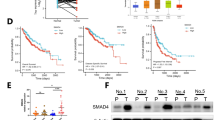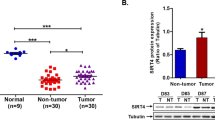Abstract
The carcinogenic role of Hepatitis B X (HBX) in hepatocellular carcinoma (HCC) remains largely unknown. Histone H3 lysine 4 methyltransferase SMYD3 was found to be over-expressed and have a pro-carcinogenic effect in HCC. The role of HBX in regulating SMYD3 activity and the corresponding C-MYC gene in HCC carcinogenesis was investigated. SMYD3 and C-MYC expression in HBV-negative HepG2 and HBV-positive HepG2.2.15 were detected by real time PCR and Western blot. After transfection of HBX into HepG2, SMYD3 and C-MYC protein expression was detected and the apoptosis and proliferation of hepatoma cells were assayed. After SMYD3 expression in HepG2 with HBX transfection downregulated by siRNA, the corresponding C-MYC expression, cellular apoptosis, and proliferation were assayed by FACS. SMYD3 mRNA and protein and C-MYC protein were significantly higher in HepG2.2.15 than in HepG2. HBX transfection resulted in enhanced SMYD3 and C-MYC expressions, decreased cell apoptosis, and increased cell proliferation in HepG2 cells. Knocking down of SMYD3 in HepG2 with HBX transfection inhibited C-MYC expression and promoted apoptosis. These results suggest that HBX upregulates SMYD3 expression in HepG2, which may promote hepatoma development and progress. C-MYC may act as a down-stream gene in HBX-SMYD3-related hepatocarcinogenesis.



Similar content being viewed by others
References
Feitelson MA, Duan LX. Hepatitis B virus X antigen in the pathogenesis of chronic infections and the development of hepatocellular carcinoma. Am J Pathol. 1997;150:1141–57.
Feitelson MA. Hepatitis B virus in hepatocarcinogenesis. J Cell Physiol. 1999;181:188–202. doi:10.1002/(SICI)1097-4652(199911)181:2<188::AID-JCP2>3.0.CO;2-7.
Su Q, et al. Expression of hepatitis B virus X protein in HBV infected human livers and hepatocellular carcinomas. Hepatology. 1998;27:1109–20. doi:10.1002/hep.510270428.
Su PF, et al. Differential DNA methylation associated with hepatitis B virus infection in hepatocellular carcinoma. Int J Cancer. 2007;121:1257–64.
Park IY, et al. Aberrant epigenetic modifications in hepatocarcinogenesis induced by hepatitis B virus X protein. Gastroenterology. 2007;132:1476–94.
Zhu R, et al. Association of p16INK4A hypermethylation with hepatitis B virus X protein expression in the early stage of HBV-associated hepatocarcinogenesis. Pathol Int. 2007;57:328–36.
Jenuwein T, Allis CD. Translating the histone code. Science. 2001;293:1074–80. doi:10.1126/science.1063127.
Hamamoto R, et al. SMYD3 encodes a histone methyltransferase involved in proliferation of cancer cells. Nat Cell Bio1. 2004;6:731–40.
Hamamoto R, et al. Enhanced SMYD3 expression is essential for the growth of breast cancer cells. Cancer Sci. 2006;97:113–8.
Chen LB, Xu JY, Yang Z, Wang GB. Silencing SMYD3 in hepatoma demethylates RIZI promoter, induces apoptosis and inhibits cell proliferation and migration. World J Gastroenterol. 2007;13:5718–24.
Secombe J, Pierce SB, Eisenman RN. Myc: a weapon of mass destruction. Cell. 2004;117:153–6.
Adhikary S, Eilers M. Transcriptional regulation and transformation by Myc proteins. Nat Rev Mol Cell Biol. 2005;6:635–45.
Felsher DW. Cancer revoked: oncogenes as therapeutic targets. Nat Rev Cancer. 2003;3:375–80.
Shachaf CM, et al. MYC inactivation uncovers pluripotent differentiation and tumour dormancy in hepatocellular cancer. Nature. 2004;431:1112–7.
Jain M, et al. Sustained loss of a neoplastic phenotype by brief inactivation of MYC. Science. 2002;297:102–4.
Su JM, et al. X protein of hepatitis B virus functions as a transcriptional co-repressor on the human telomerase promoter. Hepatology. 2007;46:402–13.
Kunizaki M, et al. The lysine 831 of vascular endothelial growth factor receptor 1 is a novel target of methylation by SMYD3. Cancer Res. 2007;67:10759–65.
Huang J, Kwong J, Sun ECY, Liang TJ. Proteosome complex as a potential cellular target of hepatitis B virus X protein. J Virol. 1996;70:5582–91.
Rahmani Z, Huh KW, Lasher R, Siddiqui A. Hepatitis B virus X protein colocalizes to mitochondria with a human voltage-dependent anion channel, HVDAC3, and alters its transmembrane potential. J Virol. 2002;74:2840–6.
Bouchard M, Giannakopoulos S, Wang E, Tanese E, Schneider RJ. Hepatitis B virus HBx protein activation of cyclin A-cyclin dependent kinase 2 complexes and G1 transit via a Src kinase pathway. J Virol. 2001;75:4247–57.
Chin R, et al. Modulation of MAPK pathways and cell cycle by replicating hepatitis B virus: factors contributing to hepatocarcinogenesis. J Hepatol. 2007;47:325–37.
Ou DP, Tao YM, Tang FQ, Yang LY. The hepatitis B virus X protein promotes hepatocellular carcinoma metastasis by upregulation of matrix metalloproteinases. Int J Cancer. 2007;120:1208–14.
Kim CM, Koike K, Saito I, Miramura T, Jay G. HBx gene of hepatitis B virus induces liver cancer in transgenic mice. Nature. 1991;353:317–20.
Yu DY, et al. Incidence of hepatocellular carcinoma in transgenic mice expressing the hepatitis B virus X-protein. J Hepatol. 1999;31:123–32.
Zheng Y, Chen WL, Louie SG, Yen TS, Ou JH. Hepatitis B virus promotes hepatocarcinogenesis in transgenic mice. Hepatology. 2007;45:16–21.
Tsuge M, et al. A variable number of tandem repeats polymorphism in an E2F–1 binding element in the 5’ flanking region of SMYD3 is a risk factor for human cancers. Nat Genet. 2005;37:1104–7.
Wang H, et al. Association of the variable number of tandem repeats polymorphism in the promoter region of the SMYD3 gene with risk of esophageal squamous cell carcinoma in relation to tobacco smoking. Cancer Sci. 2008;99:787–91.
Frank B, et al. Variable number of tandem repeats polymorphism in the SMYD3 promoter region and the risk of familial breast cancer. Int J Cancer. 2006;118:2917–8.
Choi BH, Choi M, Jeon HY, Rho HM. Hepatitis B viral X protein overcomes inhibition of E2F1 activity by pRb on the human Rb gene promoter. DNA Cell Biol. 2001;20:75–80.
Jung JK, Arora P, Pagano JS, Jang KL. Expression of DNA methyltransferase 1 is activated by hepatitis B virus X protein via a regulatory circuit involving the p16INK4a-cyclin D1-CDK 4/6-pRb-E2F1 pathway. Cancer Res. 2007;67:771–8.
Wang WH, Hullinger RL, Andrisani OM. Hepatitis B virus X protein via the p38MAPK pathway induces E2F1 release and ATR kinase activation mediating p53 apoptosis. J Biol Chem. 2008;283:25455–67.
Lara-Pezzi E, Armessila A, Majano P, Redondo J, Lopez-Cabrera M. The hepatitis B virus X protein activates nuclear factor of activated T cells (NF-AT) by a cyclosporin A-sensitive pathway. EMBO J. 1999;17:7066–77.
Maguire HF, Hoeffler JP, Siddiqui A. HBV X protein alters the DNA binding specificity of CREB and ATF-2 by protein-protein interactions. Science. 1991;252:842–4.
Wang HD, Trivedi A, Jonson DL. Hepatitis B virus X protein induces RNA polymerase III-dependent gene transcription and increases cellular TATA-binding protein by activating the Ras signaling pathway. Mol Cell Biol. 1997;17:6838–46.
Kalra N, Kumar V. The X protein of hepatitis B virus binds to the F box protein Skp2 and inhibits the ubiquitination and proteasomal degradation of c-Myc. FEBS Lett. 2006;580:431–6.
Balsano C, et al. Full-length and truncated versions of the hepatitis B virus (HBV) X protein (pX) transactivate the c-myc protooncogene at the transcriptional level. Biochem Biophys Res Commun. 1991;176:985–92.
Tu H, et al. Biological impact of natural COOH-terminal deletions of hepatitis B virus X protein in hepatocellular carcinoma tissues. Cancer Res. 2001;61:7803–10.
Terradillos O, et al. The hepatitis B virus X gene potentiates c-myc-induced liver oncogenesis in transgenic mice. Oncogene. 1997;14:395–404.
Madden C, Finegold M, Slagle B. Hepatitis B virus X protein acts as a tumor promoter in development of diethylnitrosamine-induced preneoplastic lesions. J Virol. 2001;75:3851–8.
Lakhtakia R, et al. Hepatocellular carcinoma in a hepatitis B ‘X’ transgenic mouse model: a sequential pathological evaluation. J Gastroenterol Hepatol. 2003;18:80–91.
Desjardins E, Hay N. Repeated CT elements bound by zinc finger proteins control the absolute and relative activities of the two principal human c-myc promoters. Mol Cell Biol. 1993;13:5710–24.
Acknowledgement
The paper was supported by Natural Science Foundation of China (NSF) No. 30672067 and 30700190.
Author information
Authors and Affiliations
Corresponding author
Rights and permissions
About this article
Cite this article
Yang, L., He, J., Chen, L. et al. Hepatitis B virus X protein upregulates expression of SMYD3 and C-MYC in HepG2 cells. Med Oncol 26, 445–451 (2009). https://doi.org/10.1007/s12032-008-9144-1
Received:
Accepted:
Published:
Issue Date:
DOI: https://doi.org/10.1007/s12032-008-9144-1




